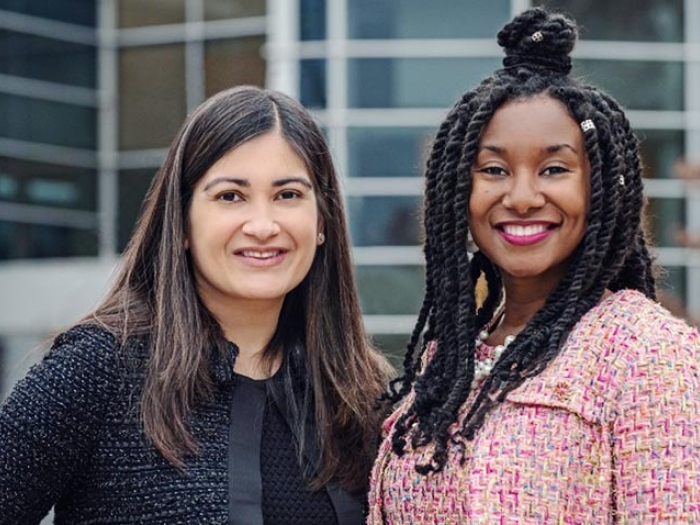Two residents highlight the need for further training when responding to harassment from patients. Now, they’re developing a training course to empower their colleagues.
7:00 AM
Author |

"Why don't you just leave the pretty girl here until you get back?" he asked. "I'm sure I could find plenty of things to do with her all day."
Olivia Killeen, M.D., still remembers those words from a geriatric patient when she was a medical student on morning rounds with her attending physician.
"Neither I, nor the resident, nor the attending physician acknowledged his words."
LISTEN UP: Add the new Michigan Medicine News Break to your Alexa-enabled device, or subscribe to our daily audio updates on iTunes, Google Play and Stitcher.
But this wouldn't be the last time Killeen, an ophthalmology resident at Michigan Medicine's Kellogg Eye Center, would experience harassment from a patient in her care.
In fact, she's not alone.
As a medical community, we must advocate for each other. We need to start addressing inappropriate behavior in real time and empower team members in all roles to do the same.Olivia Killeen, M.D.
According to a recent report from Medscape, 27 percent of physicians have experienced at least one incident of sexual harassment from patients within the past three years.
Laura Bridges, D.O., a physical medicine and rehabilitation resident at Michigan Medicine, can relate.
"I walked into a patient appointment alongside a senior physician and was greeted with, 'Hey, are you even a doctor?' I responded calmly, 'Hello, and yes, I am one of the resident physicians working here today.' The patient scoffed, 'I would never have guessed that looking at your blonde hair.'"
SEE ALSO: Women in Medicine Say #MeToo, Report 'Appalling' Experiences
Bridges and Killeen shared these experiences in a recent opinion piece with JAMA.
"We decided to write this piece as a result of various, repeated clinical experiences throughout medical training that made us feel uncomfortable and unprepared," Bridges says.
Killeen adds, "A lot of time in medical school was spent discussing how to cultivate the patient-physician relationship; when to make eye contact, when to ask open-ended questions, when to be silent. But I had no training in how to respond when the patient violated that relationship by making sexual comments."
The University of Michigan Medical School recognized that training in difficult situations, whether with peers or patients, was lacking from its curriculum. The school has recently incorporated workshops and training around subjects such as handling difficult situations while on rotation, bystander intervention training and crucial conversations.
U-M medical students are also now reading Bridges and Killeen's JAMA piece before participating in discussion groups around the subject.
Bridges and Killeen explain more and how they hope to empower their colleagues with new training.
The JAMA opinion piece is very personal. What made you decide to share these experiences?
Bridges: We felt that authoring the piece from the perspective of the medical trainee would offer unique insights, but we know that this issue impacts a much broader audience. We acknowledged the lack of discussion and training regarding uncomfortable or inappropriate patient encounters. We wanted to both raise awareness and brainstorm strategies to combat this harassment.
In the piece, you explain different harassment encounters with patients. How do these interactions affect the patient-physician relationship?
Bridges: We partner with our patients to provide the best care, and these interactions challenge the therapeutic relationship we are trying to establish. These interactions then lead to frustration and disappointment if not resolved or appropriately redirected.
Killeen: These incidents are demeaning. They hinder the therapeutic relationship, and they make our job more difficult and distract from the important work of patient care.
You mention in each encounter that your colleagues would ignore or simply not acknowledge the comments. Is this how you hoped they would react?
Killeen: We describe several incidents in which attending physicians stayed silent, giving patients tacit permission to continue bad behavior; those experiences were very disheartening.
In contrast, I am grateful for attending physicians like Dr. Julie Rosenthal, who sets a great example by calling out inappropriate comments in real time. When working with her, I feel like I have an ally in this cause.
Bridges: These scenarios are undoubtedly sensitive and often leave those involved unsure of how to respond.
SEE ALSO: 30% of Female Physicians Report Sexual Harassment at Work
We hope in the future, with the appropriate training, practice and awareness, that more physicians and staff will speak out and at a minimum acknowledge that the action or language is unacceptable. Of course safety is always a primary concern, but in safe, non-life-threatening scenarios, disrespectful behaviors are best dealt with at that time, which helps preserve the patient-physician relationship and sets boundaries.
Killeen: Everyone — front office staff, medical students, attending physicians, residents, technicians, nurses — must be empowered to advocate for themselves when they experience harassment.
Speaking of empowerment, what would you say to a fellow medical professional who is experiencing harassment?
Killeen: Speak up! Harassment is not going to stop on its own.
Since writing the JAMA piece, a number of technicians at Kellogg Eye Center have approached me to share that they frequently receive sexualized comments from patients but do not feel equipped to properly respond.
As a medical community, we must advocate for each other. We need to start addressing inappropriate behavior in real time and empower team members in all roles to do the same.
Bridges: The least beneficial response is to do nothing.
Acknowledge it. Use your voice and address the patient in real time or speak to a colleague about it later to debrief. We too often remain silent.
You're not just acknowledging that this type of behavior is happening in the medical field; you are developing solutions — specifically around the training you mentioned is needed. Can you explain a bit more about that?
Killeen: Dr. Bridges and I are currently designing a one-hour training session to strategize ways to address harassment in real time. Our session is modeled after Dr. Amy Cowan's program at the University of Utah. We intend to bring this training session to various departments at Michigan Medicine and are excited to host our first of such sessions for the ophthalmology department in April.
While our JAMA piece centered upon harassment in the form of sexist comments from patients, the same principles apply to harassment based on race, religion, etc.
Bridges: Our piece also offers various action items to target this, such as incorporating provider training sessions utilizing role-play to practice one's responses to these scenarios, establishing clear policies for dealing with harassment within clinical departments and providing informational pamphlets on what is not harassment to approach the subject from a different angle and outline appropriate boundaries for the patient and provider.
We are so grateful for the many positive responses we received in regard to our JAMA piece from staff at Michigan Medicine. We hope to equip our fellow staff members with some go-to, thoughtful responses as brainstormed by ourselves and the collective group.
Is there any education around the topic that could be done with patients?
Bridges: First and foremost, creating a culture of inclusion, diversity and respect in hospitals and clinics is so important for the equal treatment of all patients and staff. Institutional policies regarding discrimination and harassment then reinforce this culture and provide the structure to implement it effectively.
In real time, addressing inappropriate patient behavior or language in a simple, safe and direct manner can be beneficial.
Killeen: Agreed. Harassment needs to be addressed in real time, immediately after the comment was made.
Since the JAMA article was published, I have started confronting patients about inappropriate remarks. I was initially apprehensive about calling out bad behavior, worried that it could escalate an already uncomfortable situation. But it has been a very positive experience.
Many patients have immediately apologized and said something along the lines of, "I didn't mean to offend you, but I see why that was inappropriate; I will be more respectful in the future."
I am pleased to report that calling out bad behavior gets easier each time. I feel much more confident speaking up now than I did several months ago.
If physicians don't correct inappropriate behavior in our clinics, then how can we expect it to stop?

Explore a variety of healthcare news & stories by visiting the Health Lab home page for more articles.

Department of Communication at Michigan Medicine
Want top health & research news weekly? Sign up for Health Lab’s newsletters today!





